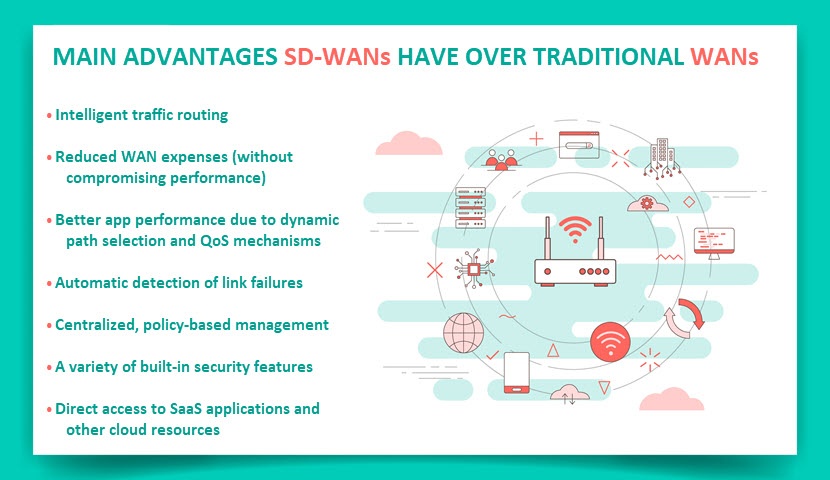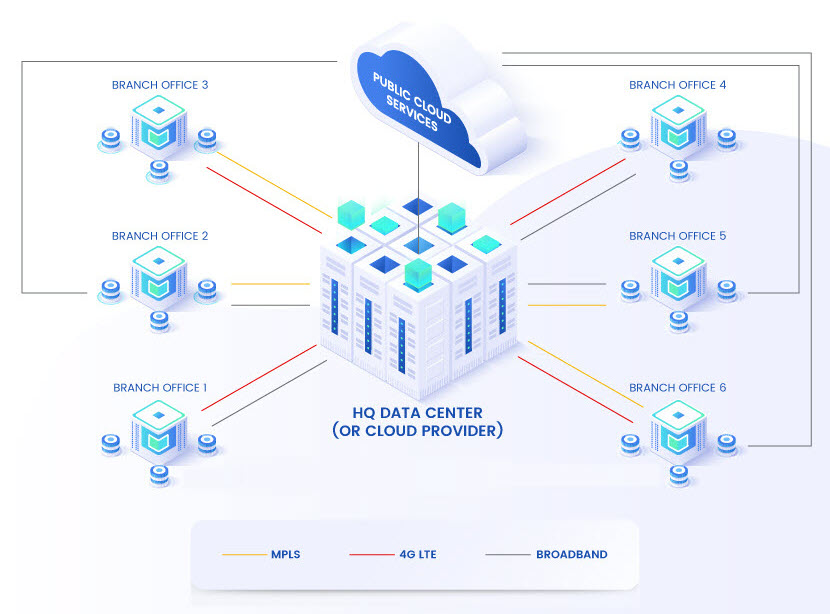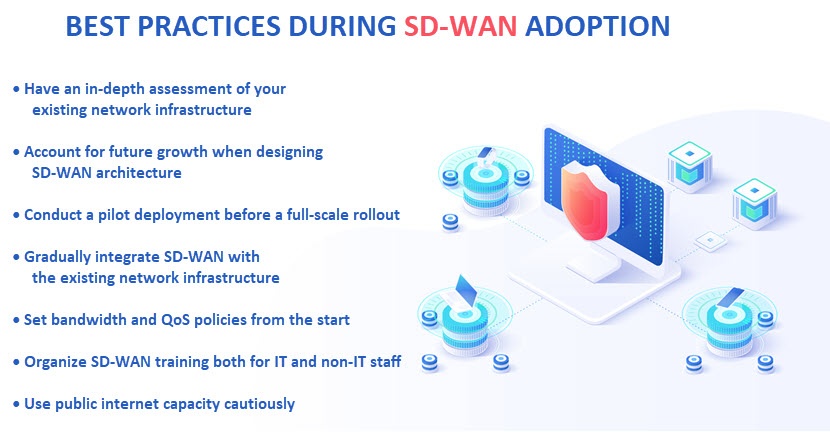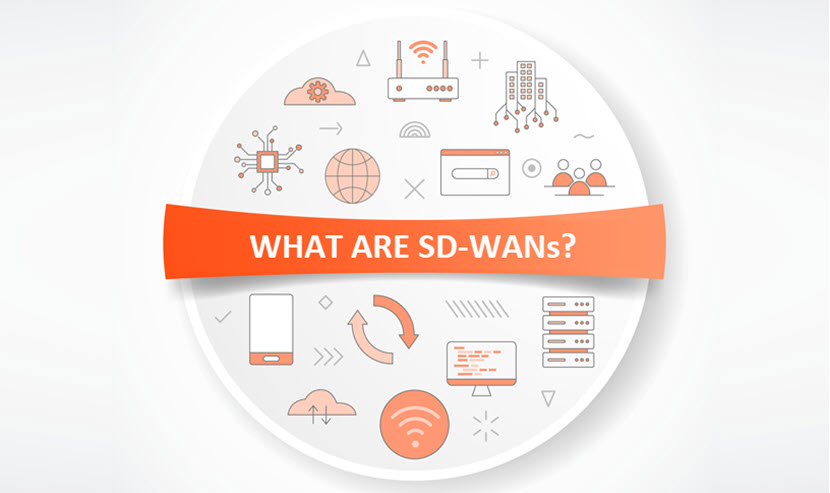An SD WAN allows an organization to utilize software-defined network (SDN) principles to create better performing WANs. SD-WANs are a great way to solve many of the problems associated with traditional WANs, such as traffic backhauling and complex management. They also improve performance. This article will explain
the basic of SD-WANs, as well as the main benefits of this technology. We also outline the go-to use cases for SD-WANs to help you assess whether software-defined networks are the right fit for your business needs.Learn about cloud networking and see the main reasons why companies decide to design, configure, and manage network resources in the cloud.
What Is SD-WAN?
An SD-WAN (software-defined wide area network) is a networking tech that enables companies to connect LANs and build WANs with software-based resources. SD-WANs add a virtualized network overlay on top of the WAN, enabling admins to manage and fine-tune the network remotely. Abstracting the software from hardware makes SD-WANs far more flexible than a standard WAN. Here are the key reasons why companies decide to adopt an SD-WAN:
Reduced networking costs.
- Improved and more consistent app performance.
- More agility in day-to-day networking operations.
- More efficient use of SaaS and public cloud apps.
- Simplified management due to network centralization.
- High levels of orchestration and automation.
- Real-time visibility over the entire network.
- Conventional routers backhaul all traffic (including cloud-destined traffic) from branch offices to a central hub or HQ data center for security inspection, a process that wastes bandwidth and often adds latency. SD-WANs send traffic from branch offices directly to the destination (for example, another office or cloud-based app, third-party servers, private clouds, etc.). SD-WAN upgrades do not require companies to overhaul their existing physical WANs
. Instead, SD-WAN elements go on top of existing hardware, simplifying the current architecture.
SD-WANs are also vital when adopting new tech and services (e.g., cloud migrations, IoT deployments, edge computing, etc.). An SD-WAN provides the scalability and flexibility required to support these initiatives.
How Does SD-WAN Work?
An SD-WAN uses physical WAN infrastructure (network hardware and connections like broadband internet fiber, wireless, LTE, or multiprotocol) and adds a software-defined virtual network overlay. The overlay creates an encrypted tunnel for traffic traveling among apps, devices, and sites.

Teams provision the overlay with low or zero-touch provisioning (ZTP) and manage it via a centralized controller that enables admins to:
Direct data flows across the network.
Monitor network performance.
- Distribute network and security policies (e.g., cloud security policy) to all connected devices.
- The controller operates either on-prem or in the cloud, and there’s no need for device-by-device configuration and management. The controller automatically and dynamically forwards traffic across the most appropriate available WAN path based on the following factors:
- Admin’s instructions.
Current network conditions.
- App traffic security.
- Quality-of-service (QoS) requirements.
- Circuit costs.
- Controllers allow real-time traffic management over WAN links. For example, an admin could instruct the controller to send latency-sensitive traffic like video calls along a more reliable MPLS connection.
- SD-WAN deployments also involve edge devices (
SD-WAN appliances or edge routers) that act as entry points to the network. Edge devices perform the following tasks: Continuously monitor the performance of local network links (e.g., latency, bandwidth, packet losses, etc. ). Report data to take instructions from the centralized controller.
- If a company decides to adopt an SD-WAN, there are three deployment options:
- The DIY approach:
The organization buys all the equipment and software necessary for SD-WAN, after which the in-house team deploys and manages the network.
- Fully managed: You outsource all aspects of SD-WAN deployment and management to a Managed Service Provider (MSP).
- Co-managed (or hybrid): The client and vendor agree to divide all SD-WAN deployment and management responsibilities.
- Ensure your team has the necessary network security know-how if you’re thinking about deploying an SD-WAN on an in-house level.SD-WAN Architecture
An SD-WAN architecture has two main elements:

The control plane, which operates at a centralized location (e.g., an organization’s HQ).
- The forwarding plane, which includes all the LANs and takes remote instructions from the control plane.
- Three main SD-WAN components enable the two planes to operate:The SD-WAN edge:
The edge is where network endpoints reside, such as a branch office, remote data center, or cloud-based platform. SD-WAN edge devices are equipped with multiple WAN interfaces that allow them to connect to various types of networks (MPLS or broadband internet), as well as cellular networks. ).
- An SD-WAN orchestrator:
- The orchestrator is the virtualized manager that monitors traffic and applies policies and protocols set by admins. An increasing number of vendors are adding AI and machine learning capabilities to their orchestrators to improve performance and troubleshooting capabilities. TheSD-WAN controller:
- The controller centralizes management and enables admins to monitor the network, set policies, and orchestrate operations. Admins use a management dashboard to configure policies, monitor network health and performance, track traffic, view app usage, and generate reports. The dashboard also enables teams to update network configurations and add or remove branch locations.SD-WAN Benefits and Drawbacks
Like all technologies, SD-WANs have both benefits and drawbacks. Weigh both pros and cons to assess whether SD-WANs are the right fit for your use case.
Benefits
Here are the primary benefits of deploying an SD-WAN:
Better app performance:
SD-WANs route network traffic dynamically based on real-time conditions (link quality, latency, congestion, etc.) SD-WANs are designed to route network traffic dynamically based on real-time conditions (link quality, latency, congestion, etc.). Such a setup leads to consistent performance and efficient use of available resources.
- Critical traffic routing: SD-WANs automatically route critical traffic to links with higher bandwidth. As a result, you get excellent availability for mission-critical apps.
- Centralized management: An SD-WAN provides a centralized management console for configuring and managing all aspects of the network (LANs, cloud resources, security policies, etc.). Such control, combined with ZTP, reduces the need for manual on-site configurations.
- Cost savings: SD-WANs enable an admin to send low-priority data over cheap public Internet connections instead of private links. You reduce costs by replacing expensive dedicated circuits with more cost-effective broadband connections.
- Top-tier scalability: An SD-WAN seamlessly scales up or down to meet current network needs. You deploy new sites and branch offices more quickly via auto configurations and zero-touch provisioning.
- Automatic failovers: An SD-WAN offers redundancy among WAN connections. If the primary connection goes down or becomes congested, the network failover to a second path occurs automatically.
- Better cloud connectivity: An SD-WAN enables a seamless extension of the WAN to multiple public clouds, making this network type ideal for multi-cloud deployments. SD-WANs provide a holistic view of all network traffic and operations. As a result, admins more easily pinpoint and resolve issues.
- Better network security: Central management and various built-in security features (VPNs, firewalls, in-transit encryption, network segmentation, etc.) Want to know more about how to keep networks secure? Check out these articles:
- DrawbacksWhile SD-WAN’s advantages are game-changing for the right use case, it also has several notable drawbacks that adopters must be aware of. Check out the following articles:
- DrawbacksWhile the advantages of SD-WAN are game-changing for the correct use case, the tech also has several noteworthy drawbacks adopters must be aware of:
High setup cost:
While an SD-WAN decreases connectivity costs in the long run, the short-term cost of licensing SD-WAN software is often substantial. High price tags apply to both in-house and third-party deployments.
Complex setup:
- While MSPs do their best to simplify deployments, introducing an SD-WAN requires the in-house team to accurately evaluate the requirements for each feature they want to roll out. The team must also plan for overall security and integration with the existing network infrastructure and legacy equipment. Vendor selection:
- Choosing the right MSP is a common challenge of SD-WAN adoption. Making the wrong choice can lead to a situation in which a company becomes unable to change providers without substantial switching costs (the so-called vendor lock-in problem). Dependency on Internet connectivity:
- SD-WANs use Internet connections alongside private connections. SD-WANs are flexible and cost effective, but they also rely on internet connectivity. Carefully plan redundancy and failover mechanisms to maintain high network availability. The necessary know-how:
- An SD-WAN operates differently than a traditional WAN. Most adopters must invest in staff training to ensure teams are ready to properly set up, manage, and optimize the new network.
New vulnerabilities:
- Adding a virtual layer on top of a WAN architecture often introduces new vulnerabilities. Also, due to geographic requirements, most SD-WANs require companies to procure connectivity from multiple providers, which can lead to weaknesses and, in some cases, compliance concerns.Carefully choose and implement security measures when deploying an SD-WAN. Pay special attention to encryption, authentication, and network access controls (NAC), plus ensure the team regularly updates all security measures.
- SD-WAN UsesSD-WAN use cases extend across many industries (retail, government, financial services, manufacturing, healthcare, etc.). Here are some of the primary uses of SD-WAN:
Branch office connectivity:

An SD-WAN is the go-to networking tech for establishing secure and reliable connections between multiple branch offices and HQ data centers.
Multi-region connectivity:
- SD-WANs are excellent at connecting geographically dispersed locations spanning different countries or even regions. An SD-WAN simplifies and secures cross-border data transfers while maintaining consistent network policies. Public cloud connections:
- SD-WANs enable companies to create direct and secure connections to public cloud providers. You transfer data straight from the branch to the cloud and back, saving time and bandwidth while ensuring high network performance.Hybrid and multi-cloud workflows:
- Hybrid and multi-cloud strategies also benefit from SD-WAN’s direct, secure, and high-performance connectivity.Remote workforce:
- SD-WANs can use cellular networks or broadband connections, which enables remote employees to connect to corporate resources securely and cost-effectively.Internet of Things (IoT) integrations:
- SD-WANs are excellent at supporting the high traffic and varying needs of IoT devices. An SD-WAN streamlines communication with distributed IoT edge devices and provides the real-time visibility you need to manage and keep your IoT devices safe (which, judging by the latest cybersecurity trends, should be your security team’s priority).Network DR:
- SD-WANs automatically reroute traffic in case of a network link failure. SD-WANs are a great asset for companies of any size. They can improve network performance, centralize management and ensure mission-critical applications remain available. However, enterprises (especially those with multiple sites worldwide) have the most compelling case for SD-WAN adoption.Ready to Revamp Your Corporate Networks?
- SD-WANs offer far greater flexibility, agility, and cost-efficiency than traditional WAN architectures. SD-WAN adoption makes sense if you want to optimize your network, improve performance of apps, and simplify management.
